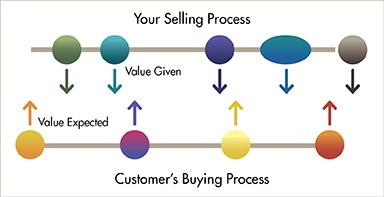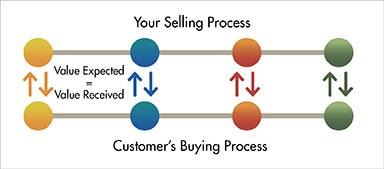Are You Creating Customers Or Just Selling?
As we get started in a new year, we assume you are looking to grow your top line revenue. Many talk about creating a sales process that supports your customer’s buying process. We have been advocates of that idea since our inception and first published on it in 2002. This content is focused on creating customers rather than just selling.

Customer Manufacturing Group, Inc.
Are your sales all you would like them to be? Is your ability to manage your sales activities as good as it should be? If the answer to either of these questions is no, perhaps the cause is because your people are “selling” rather than helping the right customers buy right.
Most Organizations Have Lost Sight of the Very Purpose of Sales
Assuming that you have a product (or service) for which there’s actually a market, most sales efforts fail today for one of two reasons:
- Your sales activities are just that — a set of activities, rather than a true process.
- You have the wrong sales process.
Addressing the easy one first: a set of sales activities not organized into a process is nothing more than a chaotic, random group of events. These result in — surprise! — a chaotic, random group of outcomes. Without a true process in place, there is no way to implement fundamental management tools that are required in any function, such as:
- Measurement and management
- Process improvement
- Reporting, coordination, and prediction.
The only way to “manage” or “improve” a sales function that is not process driven is to swap out sales people (or sales managers) and hope for better results. Sound familiar? That’s the way many sales organizations are run.
But You Say You Have a Sales Process
More sophisticated sales organizations today, however, claim to have a process in place. To the extent to which this is true, it is often the wrong process. That’s because too many sales processes have one of two origins:
- They have evolved over time to be “efficient” in terms of dollars spent and internal work flow.
- They were modeled after one of the popular sales programs sold in books and by consulting firms.
The problem with these approaches should be apparent. Sales processes constructed for internal efficiencies do little to make it easier for your customers to buy (this is one reason that re-engineering efforts comprising sales processes often failed). And sales processes mirroring an abstract one-size-fits-all approach are unlikely to have relevancy to your customers.
Most organizations have lost sight of the very purpose of Sales: to make it easy for your customers to buy from you. (Causing them to initially desire or be aware of your product or service is the job of promotion — not sales.)
Understanding Buying Processes
The key fact is that your customers have a distinct buying process they go through. They perform a set of buying actions at specific times (or during specific time periods) throughout their process. Further, at each buying step in their process they require value of some kind from you. It might be information — a brochure, pricing, specifications, deliveries, etc.; it might be a visit; it might be a demonstration; or something else . . . or it might be to be left alone.
The buying activities of your customer and the timeline along which they lie is depicted by the lower line in the diagrams below. The colored shapes represent the different buying steps, and the distance between them along the line represents time. The colored arrow going upwards, towards the upper line, depicts the value they expect from you at each of their buying steps.

Now, the upper line in this diagram represents a typical sales process. Note that the steps it performs are not mirror images of the buying steps that the customer goes through. Nor are the selling activities synchronized with the customer’s buying activities. The sales process starts and ends at different times from the customer’s buying process; the one sales step that reflects a customer’s buying step is performed at a different time than the customers’; the value delivered to the customer at each selling step is not the value expected by the customer.
If you have ever bought a car — or a multi-million dollar industrial system — you immediately recognize the dissonance we are describing between the buying process that you wanted to use and the selling process that was imposed on you.
(This misalignment between the sales process and the buying process is a key reason that so many CRM implementations have failed — they have simply automated a bad process.)

Now look at the figure above. This is how a sales process should look: aligned with the customer’s buying process. Every customer buying activity is mirrored at the appropriate time by a selling activity. The value expected by the customer at each step of their buying process is provided at that time by the selling process.
With such an aligned sales process, you can measure and manage the sales function effectively. Now throughputs and fallouts from one step in the sales process to the next reflect what is actually happening in the customer’s buying process, and predictions made about future sales events have a relationship to some real event in the customer’s process. Now process improvement — sales productivity — is actually possible, because the “quality spec” of each activity in the sales process is known: it is the alignment of that activity with the appropriate customer buying activity.
Designing the Right Sales Process
How do you construct such a selling process? Here are the steps you need to go through to do so:
- Map your customer’s buying process
- Create a selling process that mirrors and adds value to your customer’s buying process
You’ve just designed your sales process. Now you can stop selling, and start creating customers.
Need more information?
Mitchell Goozé, CSP
Customer Manufacturing Group, Inc.
302 Stonegate Circle
San Jose, CA 95110
800-947-0140
408-496-4585
Fax: 408-727-3949
www.valueaccelerationblog.com
www.valueacceleration.com


